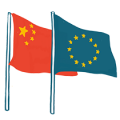

Italy pushes back against China’s technology transfer
The government of Mario Draghi is reportedly establishing a new unit within the cabinet of the prime minister to screen Foreign Direct Investments (FDI) in strategic sectors. Rebecca Arcesati and Francesca Ghiretti argue that the new division should consider looking beyond FDI and pay attention more widely to research and innovation exchanges with non-EU actors, including China.
The government of Mario Draghi is reportedly establishing a new unit within the cabinet of the prime minister to screen Foreign Direct Investments (FDI) in strategic sectors. The new division fills important gaps in investment screening and strengthens Italy’s position as a frontrunner in Europe. Although this is important progress, the unit should be concerned with more than inbound investments. Particularly, the new division should consider turning its attention towards research and innovation (R&I) exchanges. These exchanges are becoming increasingly important for economic and knowledge competition between Europe and China, with notable implications for national security. This is particularly the case since China’s government treats both FDI and R&I collaboration as strategic means to acquire foreign technology and know-how in strategic and dual-use fields.
Growing scrutiny of Chinese tech acquisitions in Italy
Draghi has made use of the so-called ‘Golden Power’ — Italy's FDI screening mechanism — more than any of the preceding governments, complicating Chinese investors’ access to strategic technologies. Since he took office in February 2021, the instrument has been used to prevent three Chinese takeovers and the terms of one increase of shares by an existing stakeholder, undo one takeover that had already been concluded during a previous administration and nip one mooted acquisition in the bud. The first time Draghi’s government used the Golden Power was to block the Chinese Shenzhen Investment Holdings from acquiring the Italian semiconductor enterprise Lpe. Key considerations likely were that Lpe specialises in epitaxy reactors, which have military applications, while the prospective acquirer had ties with the Chinese arms industry.
Second, the government stopped the acquisition of the food company Verisem by Syngenta, a Swiss firm now majority-owned by Sinochem. Later, it blocked the creation of a joint venture by the Chinese firm Zhejiang Jingsheng Mechanica and the Hong Kong branch of American Applied Materials, which produces equipment and software for the semiconductor and solar power industries. The purpose of the joint venture was to acquire Applied Materials’ screen-printing business in Italy. The latest case regards opposition to the Chinese robotics company EFORT Intelligent Equipment including technology transfer provisions in an agreement to raise its stake in the Italian company ROBOX. The deal also included an additional offer for a license agreement that would have granted the Chinese investor access to source codes and files.
While the instances above are telling of the government’s policy toward preventing Chinese investments in strategic and high-tech sectors, they are not outliers in Europe. Much more unusual is the government’s use of the Golden Power to retroactively screen and undo the acquisition of a drone-maker, Alpi Aviation, by Mars Information Technology Co. The acquisition took place in 2018, but scrutiny occurred only in 2021 due to a lack of notification by the companies involved. Furthermore, experts found that the acquirer had gone to great lengths to conceal its links with state-owned companies. A second novelty was the pre-emptive deathblow of a deal between the Italian lorry producer Iveco and FAW Jiefang, which occurred before the deal was even finalised for approval. This case has been labelled as “preventive Golden Power”. The government’s public disapproval functioned as a deterrent and caused the deal to collapse during negotiations.
Beyond investments: scientific and technological partnerships
In contrast to FDI, other avenues for the unwanted transfer of Italian tech and know-how have stayed under the radar. For the Chinese government, international scientific and technological cooperation represents a key component of its foreign technology acquisition programme, which scholarly research has documented in detail. Not all R&I cooperation with China endangers Italy’s security or economic interests. However, a cost-benefit analysis is needed to avoid being taken advantage of. The analysis should take stock of the ways Beijing seeks to leverage research and business exchanges to fill gaps in its national innovation, industrial, and defence systems. Research by the Center for Security and Emerging Technology shows that Chinese diplomats are actively scouting for Italian tech through the China-Italy Technology Transfer Center (CITTC) — a cooperation platform that emerged from an intergovernmental agreement between Italy and China. Scouting through the CITTC extends from acquisition targets to scientific breakthroughs and opportunities for licensing agreements and talent recruitment.
Research institutions are significantly exposed to the risk of sensitive technology and know-how transfer. A journalistic investigation by a consortium of European outlets found that European universities have co-published at least 3,000 scientific papers with researchers linked to universities that are directly or indirectly controlled by the People’s Liberation Army (PLA). Of those, 123 involved Italian partners. For example, researchers at the Milan Polytechnic University worked with counterparts at China’s National University of Defense Technology (NUDT), the PLA’s top scientific research institution, to improve the navigation of high-speed underwater objects, an area with clear defence applications for drones and missiles. It is not just academic papers. Chinese firms are stepping up their research partnerships in Europe too. Last October, for example, the University of Pavia inaugurated a Microelectronics Innovation Lab with Huawei, following a USD 1.7 million investment from the Chinese ICT giant. Huawei’s funding was provided by its Milan research centre, which itself was added to the US Department of Commerce’s Entity List in 2019 in a bid to cripple Huawei’s ability to obtain, design or manufacture advanced chips.
Given the Pavia lab’s focus on dual-use semiconductor research, the strategic significance of Huawei’s 5G advancements to China’s plans for military modernisation, and the company’s ties with the Chinese Communist Party and its army, an assessment of this partnership’s potential security implications seems warranted. The potential risks of collaborative research with Chinese firms are not always obvious. In Sardinia, Huawei co-runs an innovation centre focused on smart city applications, including facial recognition for public safety purposes. Through the centre, Italian talent, public money, know-how and data may inadvertently aid Huawei in developing surveillance technologies, which are tied to egregious human rights abuses in Xinjiang. That is hardly in line with Italy’s foreign policy interests and objectives.
The momentum for sharpening the focus on R&I within Italy’s economic intelligence work is already there. In its latest annual report released in February, the parliamentary committee overseeing national intelligence (COPASIR) warned about the national and economic security implications of China’s presence in the national academic and start-up spheres. The COPASIR writes that this is part of a “precise, long-term strategy which targets strategic markets, such as technological innovation, and aims to both penetrate the business community and take advantage of the incentives available for international scientific collaboration”. The report argued that collaborations between Italian universities and foreign firms that are “subject to state control” may lead to strategic technology and know-how leakage, effectively bypassing the Golden Power.
Towards a more effective economic security system
Italy’s Golden Power has been subject to numerous updates since its introduction in 2012 and, unlike screening mechanisms in other countries such as Germany, is not limited to FDI. In fact, FDI only became a focus in 2017. Its frequent updates suit the original intent of the Golden Power as a special power of the Italian Presidency of the Council of Ministers to exert oversight over economic operations that may threaten national security, defence and other strategic sectors. With its most recent updates, the Golden Power already expanded its scope to areas such as 5G, cybersecurity, banking, insurance, water, healthcare, agriculture and food, as well as strategic small and medium enterprises. A focus on investments directed at R&I in sectors with high technological intensity exists and the instrument has been used to examine technology and IP licenses.
However, several obstacles limit the application of the Golden Power to R&I. On top of the budgetary constraints to which other sectors are also subjected, the need to preserve academic and scientific freedom sometimes gives rise to information gaps, complicating policymakers’ ability to assess collaborations which may affect the national interest. Although academic freedom and independence are vital, China does not subscribe to the same ideals. The growing connections between Chinese research institutions and commercial enterprises on the one hand, and the party state’s military and security apparatus on the other, require the challenge to be taken seriously. The new unit could help strike the right balance. The decision to establish the unit is a crucial and exemplary first step towards a more effective and comprehensive economic security apparatus. If it will look beyond FDI and pay attention more widely to R&I agreements and exchanges with non-EU actors, it will do wonders for public discussion and lead to greater awareness of the issues in the academic community. And both are long overdue.
This article was first published by 9Dashline on June 23, 2022.


